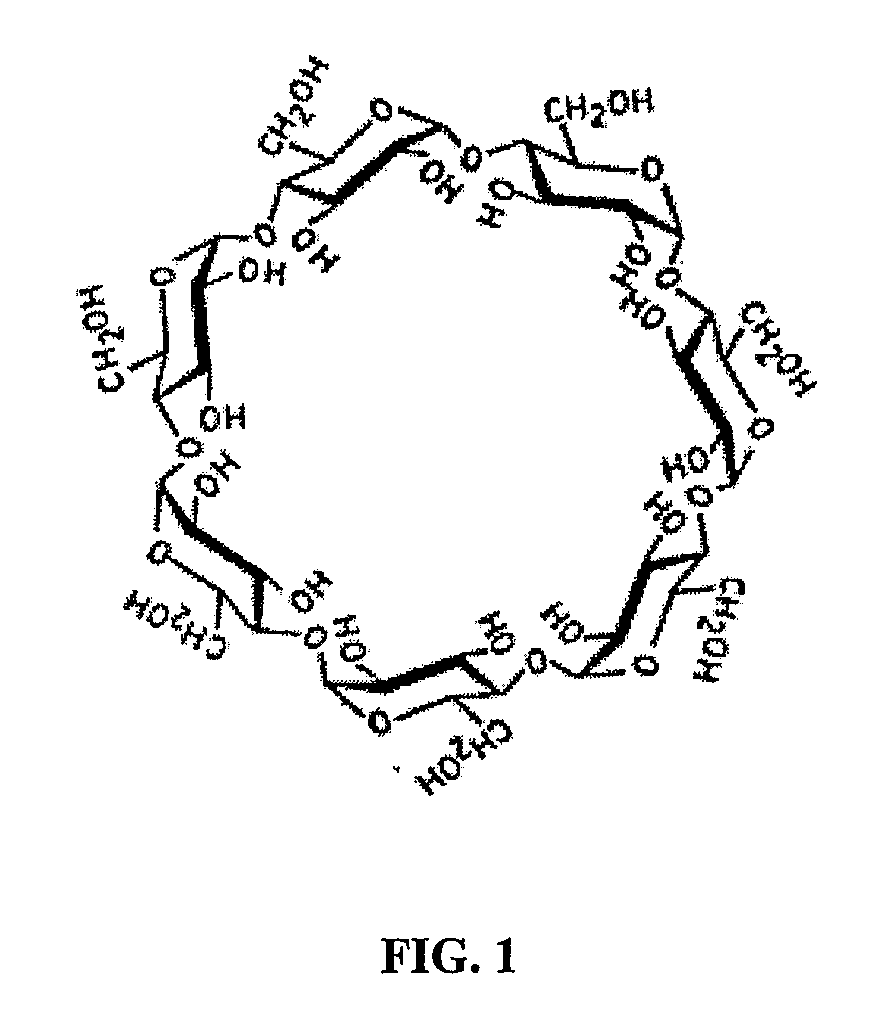Method for Altering the Tack of Materials
a technology of tack and material, applied in the direction of papermaking, non-fibrous pulp addition, other chemical processes, etc., can solve the problems of affecting the bonding of fibers, and reducing product quality, so as to reduce the tack of adhesive materials, and alter the wettability of surfaces
- Summary
- Abstract
- Description
- Claims
- Application Information
AI Technical Summary
Benefits of technology
Problems solved by technology
Method used
Image
Examples
example 1
[0029]The effect of a cyclodextrin compound on tack was measured using an adhesive both with and without the addition of a cyclodextrin compound. Cyclodextrin compounds (α- and γ) were obtained from Wacker Chemical Corporation. Carbotac 26207, a typical formulation of a pressure sensitive adhesive, is representative of a family of such adhesives commonly used in the paper industry. These adhesives enter the feedstock through mailing labels, stamps, and other products that are typically attached to a surface through the application of light pressure. They detach from the recycled paper during the repulping operation and enter the process stream.
[0030]A 0.1 weight % suspension of Carbotac in water was mixed with a 0.1 weight % suspension of α-, β-, or γ-cyclodextrin compounds in water. A film was prepared by boiling a 500 mL mixture down to 1 mL, placing two small drops on a stainless steel coupon, and spreading the drops into a film. The coupon was kept at room temperature overnight ...
example 2
[0034]The ability of cyclodextrin compound derivatives to reduce tack was determined by measuring the tack of an adhesive both with and without the addition of a cyclodextrin compound derivative. Carbotac 26171, another formulation of a pressure sensitive adhesive, is representative of a family of such adhesives commonly used in the paper industry. The following seven cyclodextrin compound derivatives were obtained from Wacker Chemical Corporation: methyl-β-cyclodextrin (A), 2-hydroxypropyl-α-cyclodextrin (B), 2-hydroxypropyl-β-cyclodextrin (C), 2-hydroxypropyl-γ-cyclodextrin (D), α-cyclodextrin (E), β-cyclodextrin (F), and γ-cyclodextrin (G).
[0035]One gram of a 0.1 weight % suspension of Carbotac 26171 in water was mixed with different amounts of the cyclodextrin compound solutions (namely A, B, C, D, E, F and G) such that the final concentration of the cyclodextrin compound in the solution was between zero and five percent. One mL of each mixture was placed on a stainless steel co...
example 3
[0037]Atomic Force Microscopy was used to independently verify the results discussed in the preceding examples. Carbotac 26207, a standard adhesive formulation, was applied to stainless steel plates and dried to a smooth film. One plate was briefly dipped into a 3% β-cyclodextrin compound solution and dried. Measurements were made on both the untreated and cyclodextrin-treated films using a conventional atomic force microscope purchased from Asylum Research, Santa Barbara, Calif. Atomic force measurements are made by measuring the deflection of the tip of a probe as it is brought towards and is attracted to the surface to be tested. The deflection of the tip is also measured as it is withdrawn from the surface.
[0038]FIG. 2 illustrates the deflection of the untreated sample. The upper curve shows the deflection of the tip as it moves toward the surface and the lower curve is the deflection as the tip moves away from the surface. The two curves are different in shape because the probe...
PUM
| Property | Measurement | Unit |
|---|---|---|
| temperature | aaaaa | aaaaa |
| temperatures | aaaaa | aaaaa |
| tack | aaaaa | aaaaa |
Abstract
Description
Claims
Application Information
 Login to View More
Login to View More - R&D
- Intellectual Property
- Life Sciences
- Materials
- Tech Scout
- Unparalleled Data Quality
- Higher Quality Content
- 60% Fewer Hallucinations
Browse by: Latest US Patents, China's latest patents, Technical Efficacy Thesaurus, Application Domain, Technology Topic, Popular Technical Reports.
© 2025 PatSnap. All rights reserved.Legal|Privacy policy|Modern Slavery Act Transparency Statement|Sitemap|About US| Contact US: help@patsnap.com


